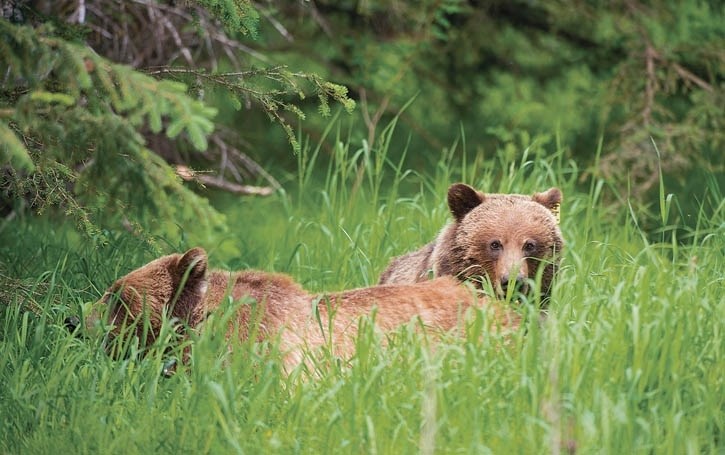ATHABASCA — The president of the Athabasca Fish and Game Association thinks the provincial government's move to lift the moratorium on grizzly bear hunting is a positive opportunity.
The Alberta government announced plans July 9 to address the growing grizzly bear population in the province with a new program almost 20 years after a moratorium on hunting the iconic animal was introduced.
The provincial government said “significantly more reports than usual of problematic — and dangerous — grizzly-human and grizzly-animal interactions” in 2024 led to the decision.
Because of this increase in encounters, Albertans with a recreational hunting licence will be eligible to be part of an approved network to handle problem grizzlies. The network will be responsible for taking care of problem bears, or those known to have been involved in interactions with both people and livestock.
The provincial ban on grizzly hunting was implemented in 2006 due to low population numbers across the province. In 2004, the grizzly population was estimated to be more than 850 bears on provincial lands, according to the government of Alberta’s 2020 grizzly bear recovery plan.
In 2021, numbers were estimated to be as high as 973, and CTV News Calgary reported the province’s population to be more than 1,500. In 2010, grizzlies were listed as a threatened species by the province.
Since the new program’s announcement, the province’s decision has been met with criticism from organizations and individuals in the conservation world.
“It took a really long time for the grizzly hunt to be suspended in the first place,” said Devon Earl, a conservation specialist with the Alberta Wilderness Association. “It took a lot of biologists and a lot of members of the public reaching out to government decision-makers at the time saying we need to protect this animal as a threatened species.”
Related: Grizzly bears back in crosshairs as Alberta lifts hunting ban in select cases
But a number of Albertan hunters, like Greg Crosland Jr, president of the Athabasca Fish and Game Association, are of a different mind when it comes to the new program.
“I’m super, super excited that this opportunity will be back for Albertans,” said Crosland. “I think it would be very positive to take out some of the bears in question that no longer have a fear of man.”
Crosland was around 20 years old at the time the ban on hunting grizzlies was introduced in 2006. A priority two hunter, he said he missed his chance to get a grizzly permit before they were halted for two decades.
“I’ve personally seen grizzlies as far norther as the sand dunes north of Fort McMurray,” said Crosland. “I’ve personally seen, on trail cameras, grizzlies in the Athabasca region, within our county.”
He cited a known population in Wildlife Management Unit (WMU) 511, directly north of Athabasca, where black bear baiting has been halted due to the number of grizzlies in the area.
“If the Grizzlies have a self-sustaining population an hour away, it just stands to reason through animals following river systems, that they’re going to move and expand their population,” said Crosland.
According to Hinterland Who’s Who, grizzly sows can have a home range as large as 600 km2, and boars up to 1,800 km2. Grizzlies have been known to travel as far as far as 250 kilometres per year, and problem bears relocated due to garbage feeding have covered distances up to 100 kilometres to return to previous feeding sites.
Crosland said growing up in Northern Alberta, he’s seen grizzlies in locations they aren’t reported to inhabit.
“About 20-some years ago, they had one trapped by Fish and Wildlife in Barrhead. If they were in Barrhead 20 years ago, the chances of them expanding their range are definitely within the threshold of reason,” he said.
When asked if he would be submitting an application to be part of the approved hunter network, Crosland was resolute: “Absolutely,” he replied, noting that a large majority of bear hunters in the province likely feel the same.
“It’s an iconic animal that’s been on the landscape for thousands of years before us, and I would rather see a hunter have the chance to deal with a problem bear then have a government employee come in, shoot it, and destroy the hide.”
The new program will allow approved hunters 24 hours to obtain authorization from a wildlife officer to kill a problem bear after receiving notification. Hunters can apply to be part of the pool through AlbertaRELM online system. Selected applicants will be contacted to provide the Ministry of Forestry and Parks.
Crosland said he wants to see ongoing efforts to manage the grizzly population in Alberta based on data, instead of the political motives he said were deciding factors in the 2006 ban.
In his opinion, the moratorium was in part motivated by a push from environmentalism ideologies. According to Crosland, the provincial government conceded the grizzly hunt to avoid criticism from green circles about Alberta’s natural resource industry.
“I think the grizzly hunt was kind of the sacrificial lamb to the government at the time, because they didn’t want to deal with the aftermath of a lot of oil and gas exploration,” said Crosland.
“I hope they use scientific methods to control it, they don’t use politics, and that they actually listen to the Alberta Fish and Game Association and other advocacy groups instead of some of the well-funded Tides groups and wildlife federation groups that just want to shut down all hunting.”


